英语词汇学精华版
- 格式:doc
- 大小:275.00 KB
- 文档页数:32
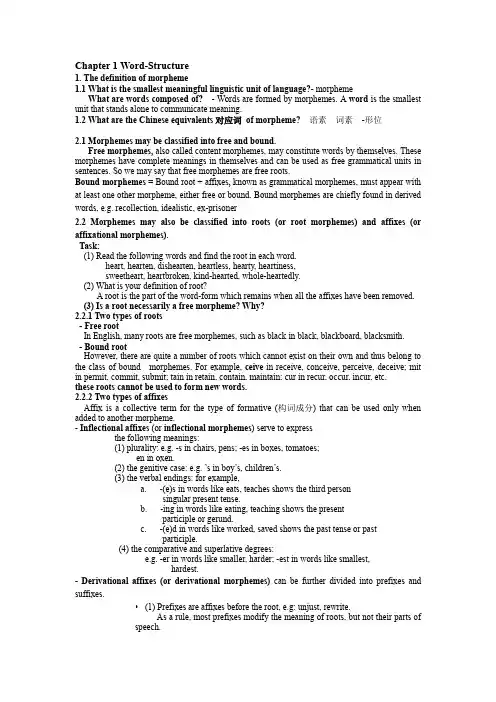
Chapter 1Word-Structure1. The definition of morpheme1.1 What is the smallest meaningful linguistic unit of language?- morphemeWhat are words composed of? - Words are formed by morphemes. A word is the smallest unit that stands alone to communicate meaning.1.2 What are the Chinese equivalents对应词of morpheme? 语素词素-形位2.1 Morphemes may be classified into free and bound.Free morphemes, also called content morphemes, may constitute words by themselves. These morphemes have complete meanings in themselves and can be used as free grammatical units in sentences. So we may say that free morphemes are free roots.Bound morphemes = Bound root + affixes, known as grammatical morphemes, must appear with at least one other morpheme, either free or bound. Bound morphemes are chiefly found in derived words, e.g. recollection, idealistic, ex-prisoner2.2 Morphemes may also be classified into roots (or root morphemes) and affixes (or affixational morphemes).Task:(1) Read the following words and find the root in each word.heart, hearten, dishearten, heartless, hearty, heartiness,sweetheart, heartbroken, kind-hearted, whole-heartedly.(2) What is your definition of root?A root is the part of the word-form which remains when all the affixes have been removed.(3) Is a root necessarily a free morpheme? Why?2.2.1 Two types of roots- Free rootIn English, many roots are free morphemes, such as black in black, blackboard, blacksmith.- Bound rootHowever, there are quite a number of roots which cannot exist on their own and thus belong to the class of bound morphemes. For example, ceive in receive, conceive, perceive, deceive; mit in permit, commit, submit; tain in retain, contain, maintain; cur in recur, occur, incur, etc.these roots cannot be used to form new words.2.2.2 Two types of affixesAffix is a collective term for the type of formative (构词成分) that can be used only when added to another morpheme.- Inflectional affixes (or inflectional morphemes) serve to expressthe following meanings:(1) plurality: e.g. -s in chairs, pens; -es in boxes, tomatoes;en in oxen.(2) the genitive case: e.g. ’s in boy’s, children’s.(3) the verbal endings: for example,a. -(e)s in words like eats, teaches shows the third personsingular present tense.b. -ing in words like eating, teaching shows the presentparticiple or gerund.c. -(e)d in words like worked, saved shows the past tense or pastparticiple.(4) the comparative and superlative degrees:e.g. -er in words like smaller, harder; -est in words like smallest,hardest.- Derivational affixes (or derivational morphemes)can be further divided into prefixes and suffixes.•(1) Prefixes are affixes before the root, e.g: unjust, rewrite.As a rule, most prefixes modify the meaning of roots, but not their parts of speech.task: list some prefixes that can modify the parts of speech.- en-(em-) as in words like embody, enrich- be- as in words like befriend, belittle- a- as in words like asleep, aside • (2) Suffixes are affixes after the root, e.g.: darkness, worker. By the addition of the suffix,the word is usually changed from one part ofspeech into another, e.g. liberation, modernize.2.3 Relationship between the two classifications of morphemesMorphemeIt is the minimal meaningful unit of language. Or it is the smallest functioning unit in the composition of words.a) Bound morphemes are morphemes which alone can be used as words .What is an allomorph?An allomorph is one of the variants of the same morpheme.语素/形位变体是同一个语素的不同形式。
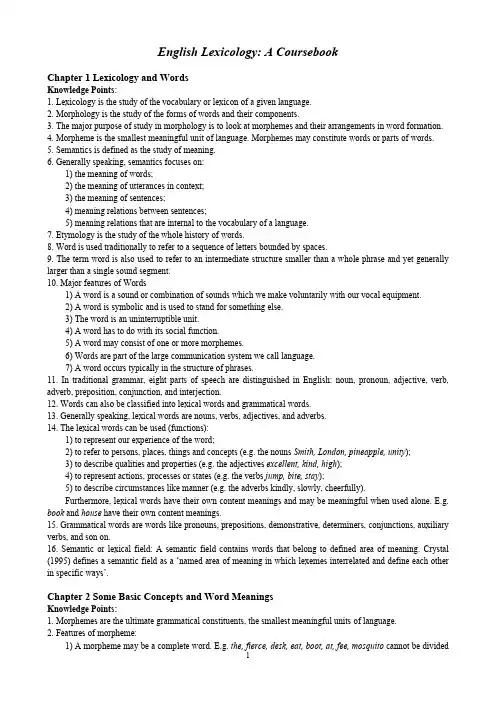
English Lexicology: A CoursebookChapter 1 Lexicology and WordsKnowledge Points:1. Lexicology is the study of the vocabulary or lexicon of a given language.2. Morphology is the study of the forms of words and their components.3. The major purpose of study in morphology is to look at morphemes and their arrangements in word formation.4. Morpheme is the smallest meaningful unit of language. Morphemes may constitute words or parts of words.5. Semantics is defined as the study of meaning.6. Generally speaking, semantics focuses on:1) the meaning of words;2) the meaning of utterances in context;3) the meaning of sentences;4) meaning relations between sentences;5) meaning relations that are internal to the vocabulary of a language.7. Etymology is the study of the whole history of words.8. Word is used traditionally to refer to a sequence of letters bounded by spaces.9. The term word is also used to refer to an intermediate structure smaller than a whole phrase and yet generally larger than a single sound segment.10. Major features of Words1) A word is a sound or combination of sounds which we make voluntarily with our vocal equipment.2) A word is symbolic and is used to stand for something else.3) The word is an uninterruptible unit.4) A word has to do with its social function.5) A word may consist of one or more morphemes.6) Words are part of the large communication system we call language.7) A word occurs typically in the structure of phrases.11. In traditional grammar, eight parts of speech are distinguished in English: noun, pronoun, adjective, verb, adverb, preposition, conjunction, and interjection.12. Words can also be classified into lexical words and grammatical words.13. Generally speaking, lexical words are nouns, verbs, adjectives, and adverbs.14. The lexical words can be used (functions):1) to represent our experience of the word;2) to refer to persons, places, things and concepts (e.g. the nouns Smith, London, pineapple, unity );3) to describe qualities and properties (e.g. the adjectives excellent, kind, high );4) to represent actions, processes or states (e.g. the verbs jump, bite, stay );5) to describe circumstances like manner (e.g. the adverbs kindly, slowly, cheerfully).Furthermore, lexical words have their own content meanings and may be meaningful when used alone. E.g. book and house have their own content meanings.15. Grammatical words are words like pronouns, prepositions, demonstrative, determiners, conjunctions, auxiliary verbs, and son on.16. Semantic or lexical field: A semantic field contains words that belong to defined area of meaning. Crystal (1995) defines a semantic field as a ‘named area of meaning in which lexemes interrelated and define each other in specific ways’.Chapter 2 Some Basic Concepts and Word MeaningsKnowledge Points:1. Morphemes are the ultimate grammatical constituents, the smallest meaningful units of language.2. Features of morpheme:1) A morpheme may be a complete word. E.g. the, fierce, desk, eat, boot, at, fee, mosquito cannot be divided、管路敷设技术通过管线敷设技术,不仅可以解决吊顶层配置不规范问题,而且可保障各类管路习题到位。
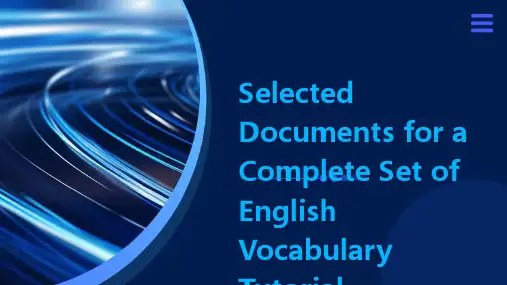
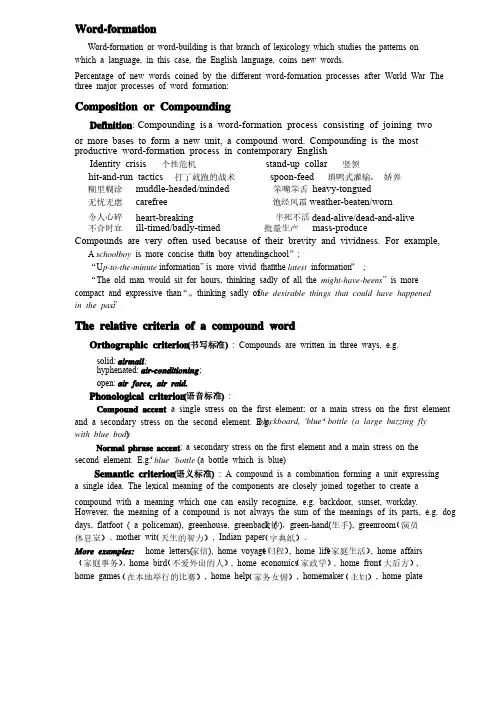
Word-formationWord-formation Word-formation or or or word-building word-building word-building is is that that branch branch branch of of of lexicology lexicology lexicology which which which studies studies studies the the the patterns patterns patterns on on which a language, in this case, the English language, coins new words. Percentage of new words coined by the different word-formation processes after World War The three major processes of word formation: Composition or CompoundingDefinition : Compounding is a word-formation process consisting of joining two or or more more more bases bases bases to to to form form form a a a new new new unit, unit, unit, a a a compound compound compound word. word. word. Compounding Compounding Compounding is is is the the the most most productive word-formation process in contemporary English . Identity crisis 个性危机stand-up collar 竖领hit-and-run tactics 打了就跑的战术spoon-feed 填鸭式灌输,娇养糊里糊涂muddle-headed/minded 笨嘴笨舌heavy-tongued 无忧无虑carefree 饱经风霜weather-beaten/worn 令人心碎heart-breaking 半死不活dead-alive/dead-and-alive 不合时宜ill-timed/badly-timed 批量生产mass-produce Compounds are very often used because of their brevity and vividness. For example, A schoolboy is more concise than “a boy attending school ”; “U p-to-the-minute information information” ” is more vivid than “the latest information ”; “The The old old old man man man would would would sit sit sit for for for hours, hours, hours, thinking thinking thinking sadly sadly sadly of of of all all all the the might-have-beens ” ” is is is more more compact and expressive than “…thinking sadly of the desirable things that could have happened in the past .”The relative criteria of a compound wordOrthographic criterion (书写标准) : Compounds are written in three ways, e.g. solid: airmail ;hyphenated: air-conditioning ; open: air force, air raid.Phonological criterion (语音标准) : Compound accent: a single stress on the first element; or a main stress on the first element and a secondary stress on the second element. E.g. 'blackboard, 'blue ‘bottle (a large buzzing fly with blue body ) ) Normal phrase accent : : a a a secondary secondary secondary stress stress stress on on on the the the first first first element element element and and and a a a main main main stress stress stress on on on the the second element. E.g. ‘ blue 'bottle (a bottle which is blue) Semantic criterion (语义标准) : A compound is a combination forming a unit expressing a a single single single idea. idea. idea. The The The lexical lexical lexical meaning meaning meaning of of of the the the components components components are are are closely closely closely joined joined joined together together together to to to create create create a a compound compound with with with a a a meaning meaning meaning which which which one one one can can can easily easily easily recognize, recognize, recognize, e.g. e.g. e.g. backdoor, backdoor, backdoor, sunset, sunset, sunset, workday. workday. However, the meaning of a compound is not always the sum of the meanings of its parts, e.g. dog days, flatfoot ( a policeman), greenhouse, greenback (美钞),green-hand(生手), greenroom (演员休息室), mother wit (天生的智力), Indian paper (字典纸). More examples:home letters(家信), home voyage (归程), home life (家庭生活), home affairs (家庭事务),home bird (不爱外出的人)(不爱外出的人), home economics (家政学), home front (大后方), home games (在本地举行的比赛), home help (家务女佣)(家务女佣), homemaker (主妇)(主妇), home plate(棒球的本垒打), home sickness (思家病)(思家病). Word order: A flower pot (花盆) a pot flower (盆花) tiptoe(脚尖) deaf-mute (聋哑者)(聋哑者)Some of them were influenced by French : court martial(军事法庭) ; president elect (当选总统); ambassador designate (尚未上任的大使)(尚未上任的大使)Classification of compoundsCompounds can be classified according to parts of speech of the compounds . noun compounds : airplane , flower potadjective compounds: w eather-beaten weather-beaten , snowwhite verb compounds: p roof-read, proof-read, baby-sit proposition compounds: notwithstanding, alongside of conjunction compounds : whenever ,whereas pronoun compounds: a nother another , myselfThe three commonest types are noun compounds, adjective compounds, andverb compounds.noun compounds• Noun + nounrainwater 雨水; ; springwater springwater 泉水; ; houseplants houseplants 室内植物;fireball 火球火球 ; ; firecracker firecracker 鞭炮 ; spacecraft/spaceship 太空船;spacesuits 太空服;mousemat ; 鼠标垫鼠标垫 Dream Team ;bar code 条形码;条形码; lip service 口头上说得好听的话;口头上说得好听的话; information highway 信息高速公路; science fiction 科幻小说;科幻小说; sugar cane 甘蔗;gaslight 煤气灯;煤气灯;• Noun + verbdaybreak 拂晓; nightfall 夜幕降临;sunset/sunrise 日落, earthquake 地震;landslip/landslide (山体滑坡); headache toothache ;stomachache ;heartbeat drumbeat ; footbeat 脚步节拍 ; wingbeat 翅翼振动 ; window-dress 布置橱窗;布置橱窗; water-supply 自来水自来水 ; snowfall 降雪量; toothpick 牙签;牙签; haircut ; pickpocket ; scarecrow 稻草人稻草人 ( scare the crow) • V erb + noun cry baby (爱哭的婴儿); playboy (花花公子) ;glowworm (发光虫); watch-dog (看家狗), swearword (骂人话), breakwater (防波提)(防波提), driveway (车道), jump suit (伞兵跳伞服,连衣裤工作服);rattle snake(响尾蛇响尾蛇) • V erb + adv / prep changeover (转变进程) ; setback (挫折挫折); breakdown (崩溃), show-off(炫耀), slip-up(疏忽,不幸事故), put-off (推迟,搪塞), follow-up (连续广告法)(连续广告法)sit-in, dropout, breakdown, walk-on, walkout, setback, take-off• Adjective + nounclear-way(超速道路), easy-chair, deadline, hard disk, soft disk ,red tape(官样文章官样文章) • adverb + noununder-clothes(内衣), after-effect (后效,副作用)(后效,副作用), upgrade(升级), overburden • V+ing + nounchewing gum(口香糖), baking powder (发酵粉), reading lamp (台灯), lodging house (分间出租供人休息用的房屋),leading article(社论), working party (作业队)(作业队)• Adverb + verb outlet(出口), upset (颠覆)(颠覆), downfall (垮台,陷落)(垮台,陷落), upstart (暴发户)(暴发户), onflow (滚滚向前)前)adjective compounds• Pre-modifier VS. Post-modifier Post-modifier ( ( ( describe describe describe a a a noun noun noun phrase phrase phrase or or or restrict restrict restrict its its its meaning meaning meaning in in some way) • Compound modifiers, because of their expressiveness and brevity, are used quite flexibly in current English, especially in journalistic writings. • noun + adjective• skin-hungry, power-hungry, news-hungry, career-hungry (急于成名的) , bloodthirsty • duty-free, tax-free, fat-free, toll-free, maintenance-free, dust-free, interest-free, care-free, ice-free, danger-free, nuclear-weapon-free • water-proof, fire-proof, bullet-proof, rain-proof, bomb-proof, vibration-proof • air-sick, seasick, car-sick, home-sick, heartsick (沮丧的) • user-friendly, reader-friendly • profit-conscious,time-conscious, class-conscious, environment-conscious, security-conscious • slap-happy(被打得晕头转向的) boxer , trigger-happy (嗜杀成性的)gangster , travel-happy(对旅游入迷的) • accident-prone, crisis-prone (危机四伏的),error-prone, • air-tight(不透气的),water-tight, light-tight(不透光的), rain-tight • work-shy(不愿工作的),camera-shy(怕上镜头的), publicity-shy (不愿出头露面的) • color-blind, night-blind • blood-weary (厌战的),travel-weary(旅途劳累的) •stone-deaf, skin-deep, snow-white, ice-cold, knee-deep, paper-thin, mirror-bright, feather-light, fire-hot, crystal-clear, waist-high, shoulder-high, life-long, grass-green, dog-tired, threadbare (穿旧的)(穿旧的) • college-bound/preparatory (准备考大学的),labor-short (缺乏劳动力的),top-heavy(头重脚轻的),penny-wise(小事聪明的) , oven-fresh (刚出炉的) line-dry(一晾就干的一晾就干的),world-famous • adjective + adjectivewet-cold, wet-cold, icy-cold, icy-cold, icy-cold, red-hot, red-hot, red-hot, white-hot, white-hot, white-hot, bitter-sweet, bitter-sweet, bitter-sweet, deaf-mute, deaf-mute, deaf-mute, shabby-genteel(shabby-genteel(穷酸的),dead-alive(半死不活的),dark-blue, dark-blue, deep-blue, deep-blue, deep-blue, light-blue, light-blue, light-blue, pale-blue, pale-blue, pale-blue, bright-red, bright-red, bright-red, bloody-red, bloody-red, yellow-green, yellowish-green ,social-political• V+ing + adjectivesteaming-hot/smoking-hot steaming-hot/smoking-hot ((滚烫的,热气腾腾的),soaking-wet/wringing-wet(湿淋淋的,湿得可拧出水来的),biting-cold/freezing-cold (冷得刺骨的,冰冷的) • Adverb/Prep + adjectiveever-victorious (战无不胜的),over-cautious, all-round (全面的全面的), far-reaching (深远的,广泛的),evergreen (tree), wide-awake (机警的),over-sensitive, over-anxious, under-ripe (不成熟的),too-rapid • noun +V+ingpeace-loving, time/space/energy/labor-saving, time-consuming, summer-flowering(夏季开花的), ocean-going (远洋的), fault-finding, record-breaking, heart-breaking, hair-raising, side-splitting (令人捧腹的),thirst-quenching (解渴的),man-eating• noun + V+edheart-felt(衷心的), air-born (空降的,(空降的,空运的), home-made, travel-worn (旅行得疲乏的), hen-pecked, book-filled, poverty-stricken, weather-beaten, thunder-struck, suntanned • adjective/adverb + V+ingfresh-frozen(速冻的), easy-going(随和的), familiar-sounding (听起来熟悉的),hard-working, ever-lasting (永恒的) • adjective/adverb + V+ednewly-developed, well-balanced, far-fetched (牵强附会的),half-baked(烤得半生不熟的,肤浅的), hard-won (来之不易的),quick-frozen (速冻的), new-laid (eggs), so-called, fresh-caught, newly-built, well-informed, well-organized • noun + Noun+edhot-tempered(急性子的),chicken-hearted (胆怯的,软弱的),honey-mouthed, paper-backed (平装本的), eagle-eyed(目光尖锐地) • adjective/adv. + Noun+edshort-sighted, short-sighted, tender-hearted, tender-hearted, tender-hearted, sweet-hearted(sweet-hearted(性情温和的), ), green-fingered(green-fingered(擅长园艺的),open-handed, single-handed, bald-headed, empty-headed, hot-headed, kind-hearted, light-hearted, whole/half-hearted, absent-minded, narrow/broad-minded, double-faced, straight-faced, blue-eyed, muddle-minded/headed muddle-minded/headed ((糊里糊涂) ) , , , commercially-minded, commercially-minded, commercially-minded, heavy-tongued heavy-tongued heavy-tongued ((笨嘴笨舌的),middle-aged, middle-aged, cold-blooded, cold-blooded, cold-blooded, strong-bodied, strong-bodied, strong-bodied, rosy-cheeked, rosy-cheeked, rosy-cheeked, apple-cheeked, apple-cheeked, apple-cheeked, close/tight-fisted(close/tight-fisted(吝啬的), bare-footed, white-haired, high-heeled, ill-intentioned, weak-kneed (易屈服的),long-legged, close/tight-lipped (嘴紧的), ill-mannered, thick/thin-skinned (脸皮厚/薄),high-spirited, iron-willed, iron-willed, quick/short/slow/bad-tempered, quick/short/slow/bad-tempered, quick/short/slow/bad-tempered, glib-tongued glib-tongued glib-tongued ((油嘴滑舌的),loose-tongued(嘴不严的) • adjective + Nounlong-distance, full-length (未删节的),white-collar, red-letter(喜庆的), ,full-time, first-rate, high-speed, high-level, low-frequency, left-hand, real-time(实时的), long-range, deep-sea (fish) • Verb + Nounbreak-neck (危险的), telltale(搬弄是非的), cut-rate (减价的,次等的减价的,次等的)• Phrases or sentencesat-risk (处境危险的), in-your-face (明目张胆的), devil-may-care(不顾一切的), dog-eat-dog (狗咬狗的), round-the-clock, on-the-spot, cards-on-the-table, matter-of-fact, never-to-be-forgotten, once-in-a-life-time, off-the-cuff (临时想起的意见)opinion, back-up (备用) a stand-up collar (竖领), a walk-in closet (走入式大壁橱),a see-through shirt (透明的衬衫)(透明的衬衫)(透明的衬衫) take-home pay ,cross-border raid ,a keep-fit class (保健班)(保健班)(保健班) verb compoundsThe common way to form a compound verb is by means of back-formation. The back-formation back-formation is is is a a a process process process of of of word word word formation formation formation by by by which which which a a a word word word is is is created created created by by by dropping dropping dropping the the supposed or imagined affixes Housekeeping → housekeep, test-drive(试车),machine-gun, nickname, spotlight, honeymoon, honeymoon, outline, outline, outline, speed-read, speed-read, speed-read, soft-land, soft-land, soft-land, vacuum-clean, vacuum-clean, vacuum-clean, mass-produce, mass-produce, mass-produce, sight-see, sight-see, sight-see, proof-read, proof-read, tape-record, chain-smoke, ghost-write, air-condition, baby-sit, window-shop, spoon-feed, hen-peck, snowball, middle-road(走中间道路), chain-react, face-harden(使表面硬化), wire-pull (幕后操纵),daydream, skyrocket, sleepwalk, highlight, safeguard, whitewash, sweet-talk,job-hop A compound verb can also be formed by means of analogy1.chain-drink: from chain-smoke 2.bottle-feed: feed from a bottle. from breast-feed:• feed from a mother's breast A compound verb can also be formed by means of verb phrasesoverwork, withhold(扣留), cross-question(盘问),upbuild (建立建立), uplift, uproot, fast-talk(花言巧语地企图说服),off-load(卸货),outeat(吃得比……多),outgo, outgrow , ill-treat, overhear, overtake, undergo, underline, undermine, undertake, Affixation or DerivationIt is a process of forming new words by the addition of a word element, such as a prefix, suffix, or combining form, to an already existing word. A combining form is a bound morpheme, which was originally a full word in Latin or Greek, such as auto-(from GK a utosautos self). 据统计下列14个词根和20个词缀出现在词典里10,000多个英语单词中词根词前缀前缀 词根Precept pre- (before) capere (take, seize) detain de- (away, from) tenere (hold, have) intermittent inter- (between) mittre (send) offer ob- (against) ferre (bear, carry) Insist in- (into) stare (stand) monograph mono- (alone, one) graph (write) epilogue epi (upon) egein (say, study) 词根词前缀前缀 词根aspect ad- (to, toward) spicere (see) com- (together) plicare (fold) uncomplicated un- (not); c omnonextended non- (not); e x ex- (out of) tendere (stretch) reproduction re- (back, again); pro- (forward) ducere (lead) dis- (apart from) ponere (put, place) indisposed in- (not); d isoversufficient over - (above); s ub sub - (under) facere (make, do) mistranscribe mis - (wrong); t rans trans - (across) scribere (write) Number-related prefixes from Latin prefix meaning examples uni- one uniform duo- two duet (二重唱二重唱/奏)奏) tri- three trio (三人组)三人组)三人组) quad-, quart- four quadruplets (四胞胎)四胞胎)四胞胎) quint- five quintuplets sext six sexet (六人组)六人组)六人组) sept seven september (7th month, Roman calendar) oct- eight october nona nine nonagenarian (90-99岁的人)岁的人)Number-related prefixes from Latin deca- ten decade cent- hundred centigrade (一百度的)一百度的)一百度的) multi- many multiply prim-, prin- first primary secund second secondary ambi both (双)双)双) ambivalent (两种价值观的,有矛盾心理的)两种价值观的,有矛盾心理的) equi- equal equidistant (等距离的)等距离的)等距离的) omni- all omnipotence (全能)全能) semi-, sem half semester (half a year 学期)学期)demi- half demitasse (half a cup for serving coffee (一小杯清咖啡)一小杯清咖啡)Number-related prefixes from Greek prefix meaning examples Mono- one monologue duo-, di- two dialogue tri- three triangle tetra- four tetrameter (四音步诗)四音步诗) penta- five pentameter ,pentagon hexa- six hexagon hepta- seven heptagon deka-, dec- ten decathlon hemi- half hemisphere pan- all pandemic (大流行病)大流行病)I.Prefixation The definition of prefixation Prefixation Prefixation is is is the the the formation formation formation of of of new new new words words words by by by adding adding adding prefixes prefixes prefixes to to to stems. stems. stems. Prefixes Prefixes Prefixes do do do not not generally change the word-class of the stem but only modify its meaning. However, there is an insignificant number of class-changing prefixes Non-class-changing prefixes: n atural-unnatural, like-dislike, fair-unfair natural-unnatural, like-dislike, fair-unfairClass-changing prefixes: force-enforce, danger-endanger , form-deform, little-belittle, war-postwar, college-intercollegeThe classification of prefixes In some reference books, prefixes (and suffixes) are classified according to their source, but this does not seem to help from a practical point of view. view. It seems It seems more helpful to classify the most important productive prefixes by their meaning into the following ten categories: The most productive prefixesPrefixes which are negative a-, dis-, in-, non-, un- Prefixes which are reversative or privative de-, dis-, un- Prefixes which are pejorative mal-, mis-, pseudo-Prefixes which are of degree or size arch-, arch-, extra-, extra-, extra-, hyper-, hyper-, hyper-, macro-, macro-, macro-, mini-, mini-, mini-, out-, out-, out-, over-, over-, sub-, super, sur-, ultra-, under- Prefixes which are of attitude anti-, co-, contra- counter-, pro- Prefixes which are locative extra-, fore-, inter-, intra-, super-, tele-, trans-, Prefixes which are of time and order ex-, fore-, pre-, post-, re- Prefixes which are of number semi-, uni-, mono-, bi-, di-, tri-, multi-, poly- Prefixes which are of a miscellaneous category Auto-, neo- pan-, proto-, vice-1.Negative prefix a-/an- amoral, asexual, atheism, anacid, anarchy, dis- dishonest, discontent, disobey, disagree in- Incomplete, Incomplete, inconsistent, inconsistent, inconsistent, incorrect, incorrect, incorrect, invulnerable, invulnerable, invulnerable, illogical, illogical, illogical, illegal, illegal, impolite, immoral, imbalance, irrational, irregular non- nonviolent, non-cooperation, nonautomatic, nonadjustable, nonalcoholic un- uninformative, unexpected, unease, unrest 2.Reversative or privative prefix 含“消除”意思意思 de- defrost, deregulation, degeneration, denationalize ,dehydrate depollute, devalue, decentralize un- undo, unpack, untie, unwrap, unmask dis- disconnect, dishearten, disinterested(公正的,无私的), disambigulate 3.Pejorative prefix mis- misguide, misapplication, misbehavior, mischoice, mal- maladjustment, maldigestion, malfunction, maldevelopment,maltreat, malodorous, malnutrition pseudo- pseudonym, pseudoscience, pseudoclassic, pseudo-friend, pseudodemocratic, 4) Prefixes of degree or size hyper- hyperactive, hypercritical, hyperaggressive, hypercautious ultra- ultramodern, ultrasecret, ultraclean, ultrasonic, ultraconservative mini- minibus, minicamera, miniskirt out- outdo, outgrown, outlive over- overwork, overestimate, overemphasize, overabundance, overburden under- underdeveloped, underpopulation, undergraduate super- supermarket, superpower, superstar sub- subadult, subtitle, subbreed, subatom 5) Prefixes of orientation and attitude co- Co-author, co-star, co-prosperity, cooperation counter- Counterexample, counterclaim, counteractive, counterattack, counterculture, counterpart anti- anti-abortion, anti-art, antiwar, antibacterial, antisocial, anticancer, antibody pro- pro-American, pro-American亲美的, pro-Communist, pro-student, proslavery 6) Locative prefixes fore- forearm, forehead inter- international, intergovernmental, interdisciplinary, intercollege trans- transatlantic, transoceanic, transform, transplant tele- telephone, telegram, telecommunication U.S. intercontinental missile洲际导弹洲际导弹 是指射程在8000千米以上的导弹。
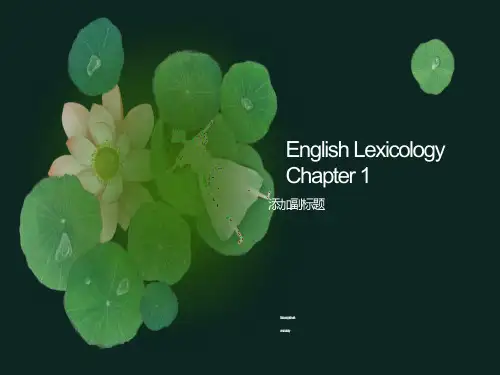
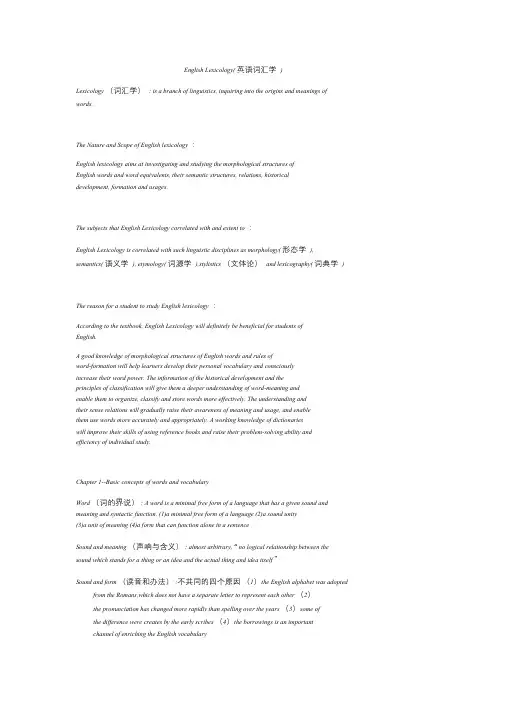
English Lexicology( 英语词汇学)Lexicology (词汇学): is a branch of linguistics, inquiring into the origins and meanings of words.The Nature and Scope of English lexicology :English lexicology aims at investigating and studying the morphological structures ofEnglish words and word equivalents, their semantic structures, relations, historical development, formation and usages.The subjects that English Lexicology correlated with and extent to :English Lexicology is correlated with such linguistic disciplines as morphology( 形态学), semantics( 语义学), etymology( 词源学),stylistics (文体论)and lexicography( 词典学)The reason for a student to study English lexicology :According to the textbook, English Lexicology will definitely be beneficial for students ofEnglish.A good knowledge of morphological structures of English words and rules ofword-formation will help learners develop their personal vocabulary and consciouslyincrease their word power. The information of the historical development and theprinciples of classification will give them a deeper understanding of word-meaning andenable them to organize, classify and store words more effectively. The understanding andtheir sense relations will gradually raise their awareness of meaning and usage, and enablethem use words more accurately and appropriately. A working knowledge of dictionarieswill improve their skills of using reference books and raise their problem-solving ability and efficiency of individual study.Chapter 1--Basic concepts of words and vocabularyWord (词的界说) : A word is a minimal free form of a language that has a given sound and meaning and syntactic function. (1)a minimal free form of a language (2)a sound unity(3)a unit of meaning (4)a form that can function alone in a sentenceSound and meaning (声响与含义) : almost arbitrary, “ no logical relationship between the sound which stands for a thing or an idea and the actual thing and idea itself ”Sound and form (读音和办法) :不共同的四个原因(1)the English alphabet was adopted from the Romans,which does not have a separate letter to represent each other (2)the pronunciation has changed more rapidly than spelling over the years (3)some ofthe difference were creates by the early scribes (4)the borrowings is an importantchannel of enriching the English vocabularyVocabulary (词汇): all the words in a language make up its vocabularyClassification of English Words :By use frequency:basic word stock&nonbasic vocabularyBy notion:content words&functional wordsBy origin:native words&borrowed wordsThe basic word stock (根本词汇) : is the foundation of the vocabulary accumulated over centuries and forms the common core of the language. Though it constitute a smallpercentage of the EV, it is the most important part of vocabulary.The Fundamental Features of the Basic Word Stock( 基本词汇的特征) :1)All-National character (全民通用性most important )2)Stability (相对稳定性)3)Productivity (多产性)4)Polysemy (多义性)5)Collocability (可搭配性)没有上述特征的words: (1)Terminology( 术语) (2)Jargon (行话)(3)slang (俚语)(4)Argot (暗语)(5)Dialectal words( 方言) (6) Archaisms (古语)(7) Neologisms (新词语):Neologisms means newly-created words or expressions, or words that have takenon new meanings.(email)Content words/notional words 实词( cloud, run walk, never, five, frequently ) andfunctional words/empty words 虚词( on, of, and, be, but )Native Words and Borrowed WordsNative words (本族语词): known as Anglo-Saxon words (50,000-60,000), are wordsbrought to Britain in the 5th century by the Germanic tribes. (mainstream of the basicword-stocks).Two other features:(1)neutral in style (2)frequent in useBorrowed words/Loan words (外来语词): words taken over from foreignlanguages.(80% of modern EV)4 Types of loan words:1) denizens( 同化词): (shirt from skyrta(ON))2) aliens (非同化词/ 外来词):are borrowed words which have retained their original pronunciation and spelling (kowtow (CH) 磕头)3) translation loans( 译借词): 按其他语言方式组成英语long time no see (from China)4) semantic loans (借义词):they are not borrowed with reference to the form,but their meanings are borrowedChapter 2 the development of the English VocabularyThe Indo-European Language Family( 印欧语系)The Eight Groups in Indo-European Family of Languages (8 大印欧语群)The Eastern set:(1)The Balto-slavic Group (波罗的-斯拉夫语族):Russian,Bulgarian,Polish,Czech etc. (2)The Indo-Iranian Group (印度-伊朗语族):Hindi,Bengali,Persian etc.(3)The Armenian Group (亚美尼亚语族):Armenian.(4)The Albanian Group (阿尔巴尼亚语族):Albanian.The Western set:(5)The Hellenic Group (古希腊语族):Greek.(6)The Italian Group (意大利语族):Latin ,Romance languages(French,Italian,Spanish, portuguese,Romanian) etc.(7)The Celtic Group (凯尔特语族):Irish,Welsh,Breton etc.(8)The Germanic Group (日耳曼语族):Flemish,German,Dutch,Scandinavian(Norweigian, Swedish,Danish,Icelandic) etc.The Three Stages of Development of the English Vocabulary:1 Old English (450-1100) (vocabulary 50,000 to 60,000):was I high inflected language.2 Middle English (1150-1500):retaines much fewer inflections3 Modern English (1500-up to now): in fact more than 25% of modern E words comealmost directly from classical languages. In Modern E, words endings were mostly lost withjust a few expections.English has evolved from a synthetic language(Old English) to thepresent analytic language.Modes of Vocabulary Development( 词汇的发展模式):1)creation 创造新词:the formation of new words by using the existing materials,namelytoots,affixes and other elements.( 最重要方式)2)semantic change 旧词新义:does not increase the number of word forms but createmany more new useages of the words.3) borrowing 借用外来词:constitute merely 6 to 7 percent of all new wordsReviving words or obsolete words also contributes to the growth of English vocabularythough quite insignificant.Chapter 3 Word Formation IMorpheme( 词素) :the smallest functioning unit in the composition of wordsAllomorph( 词素变体) : is a different variant form of a morpheme ,differ in phonologicaland spelling form, but at the same in function and meaningType of Morpheme( 词素的分类)(1)Free Morphemes (自在词素) : have complete meaning in themselves and can be used as free grammatical units in sentences. A free morpheme is one that can stand by itself.(independent).(2)Bound Morpheme( 粘着语素): A bound morpheme is one that cannot stand by itself.Bound Morpheme includes two types: (1) bound root( 粘附词根) (2)Affix( 词缀)Affixes can be put into two groups:1)Inflectional affixes ( 屈折词缀):affixes attached to the end of words to indicategrammatical relationships are inflectional,thus known as inflectional morphemes.2)Derivational affixes( 派生词缀): A) prefix: A prefix comes before words. B)suffix:Anadjective suffix (描述词后缀) that is added to the stem, whatever class is belongs to , theresult will be an adjective.Free Morpheme =free root (自在词根)Morpheme( 词素)Bound root prefixbound derivationalaffix suffixinflectionalRoot and stem (词根和词干)The differences between root and stem:A root is the basic form of a word which cannot be further analyzed without total loss ofidentity.A stem is the surplus part after the cutting of inflectional morpheme in a word withinflectional morphemes,can be further analyzed, it sometimes could be a root.Chapter 4 Word-Formation II( 构词法)1.Affixation 词缀法(Derivation 派生法):the formation of words by adding word-formaing or derivational affixes to stem.(1)Prefixation( 前缀法):It's the formation of new words by adding a prefixes to stems.1)Negative prefixes( 否定前缀): un-,non-,in-,dis,a- ,il-,ir-,im-,etc.disobey(not obey)2)Reversative prefixes (逆反前缀): un-,de- ,dis- etc. unwrap(open)3) Pejorative prefixes: mis (贬义前缀):mis- ,mal-, pseudo- etc.misconduct(bad behaviour)4) Prefixes of degree or size( 程度前缀):arch-,extra-,hyper-,macro-,micro-,mini-,out-,over-,sub-,super-,sur-,ultra-,under-,ect.overweight5) Prefixes of orientation and attitude (倾向态度前缀):contra-,counter-,anti-,pro-etc.anti-nuclear6)Locative prefixes (方位前缀):extra-,fore-,inter-,intra-,tele-,trans-, etc. extraordinary(more than ordinary)7) Prefixes of time and order (时间和顺序前缀):fore-,pre-,post-,ex-,re- etc. monorail(one rail)8) Number prefixes (数字前缀):uni- ,mono-, bi- ,di-, tri-,multi- ,poly- ,semi- ,etc.bilingual(concerning two languages)9) Miscellaneous prefixes (混杂前缀):auto-, neo-, pan-, vice-.vice-chairman(deputy chairman)(2)Suffixation (后缀法): It's the formation of a new word by adding suffixes to stems.1)noun suffixes 2)adjective suffixes 3)Adverb suffixes 4)verb suffixespounding 复合法(also called composition )Compounding: is the formation of new words by joining two or more stemsCompounds are written in three ways: solid 连写(airmail) ,hyphenated 带连字符(air-conditioning)and open 分开写(air force, air raid)Formation of compounds (复合词的办法)(1)noun compounds :e.g. : air + plane = airplane,flower + pot = flower pot(2)adjective compounds :e.g. acid + head = acid-head(3)verb compounds :e.g. house + keep = housekeep3.Conversion 转类法Conversion: is the formation of new words by converting words of one class to anotherclass. (功用转化,又名零派生 .functional shift/zero-derivation )4.Blending 拼缀法Blending : is the formation of new words by combining parts of two words or a word plus apart of another word. e.g: motor + hotel = motel, smoke + fog = smog, formula +translation = FORTRAN5.Clipping 截短法Clipping:is to shorten a longer word by cutting a part off the original and using whatremains instead.e.g. plane from airplane, phone from telephone. 四种办法:1).Front clippings 删节前面(phone from telephone)2).Back clippings 删节后面(dorm from dormitory)3).Front and back clippings 前后删节(flu from influenza)4).Phrase clippings 短语删节(pop from popular music)6.Acronymy 首字母缩写法Acronymy:is the process of forming new words by joining the initial letters of names ofsocial and political organizations or special noun phrases and technical terms.(1)Initialism (首字母缩写词法): initialisms are words pronounced letter by letter. e.g.:BBC(for British Broadcasting corporation)(2)Acronym (首字母拼音法):Acronyms are words formed from initial letters butpronounced as a normal word. E.g.:TEFL(teaching English as a foreign language)7.Back-formation (逆生法,逆构词)Back-formation is considered to be the opposite process of suffixation. It?s the method ofcreating words by removing the supposed suffixes. (greed from greedy)8.Words From Proper Name( 专有名词转成法):Names of people, places, book, and tradenames (e.g.: sir watt siemens( 人名) -- watt (瓦特,电功率单位)Chapter 5 Word MeaningThe meanings of “Meaning( “意”义”的意义)Reference (所指):It is the relationship between language and the word. It is the arbitraryand conventional. It is a kind of abstraction, yet with the help of context, it can refer tosomething specific.Concept (概念):which is beyond language, is the result of human cognition( 认识),reflecting the objective world in the human mind.Sense(含义):It denotes the relationship inside the language. ,The sense of an expressionis its place in a system of semantic relat ionships with other expressions in the language.?Motivation (理据):It accounts for the connection between the linguistic symbol and itsmeaning.1) Onomatopoeic motivation (拟声理据):words whose sounds suggest their meaning, forthese words were creates by imitating the natural sounds or noises. Knowing the sounds ofthe words means understanding the meaning. E.g.: bang, ping-pong, ha ha.2)Morphological motivation (形态理据):multi-morphemic words and the meaning of manyare the sum total of the morphemes combines. E.g.: airmail, miniskirt . 破例: black market,ect.3)Semantic motivation (词义理据):refers to the mental associations suggested by theconceptual meaning of a word. It explains the connection between the literal sense andfigurative sense of the word. E.g:the foot of the mountain(foot)4)Etymological motivation (词源理据):the history of the word explains the meaning of theword. E.g:pen-featherTypes of meaning( 词义的类别)1.Grammatical Meaning (语法含义) :indicates the grammatical concept or relationships(becomes important only in actual context)2.Lexical Meaning (词汇含义)(Lexical meaning and grammatical meaning make up the word-meaning)Lexical meaning has 2 components 内容: Conceptual meaning( 概念意义) and associativemeaning( 关联意义)1)Conceptual meaning( 概念意义): also known as denotative meaning( 外延意义) is themeaning given in the dictionary and forms the core of word-meaning.2)Associative meaning( 关联意义):is the secondary meaning supplemented to theconceptual meaning.[4types:(1) Connotative (内在意义): the overtones or associations suggested by the conceptual meaning, traditionally known as connotations.( 例如“母亲”经常与“爱”关“心”温“柔”联系起来)(2) Stylistic (文体含义): many words have stylistic features, which make them appropriate for different contexts.(3)Affective(感情意义):indicates the speaker?s attitude towards the person or thingin question. 这种情感价值观分两类:褒义和贬义appreciative & pejorative(4) Collocative (调配含义): is the part of the word-meaning suggested by the words before or after the word in discussion.]Chapter 6 --Sense relation and semantic field (语义联系和语义场)Polysemy (多义联系)Two approached to polysemy (多义联系的两种研讨办法) :1.diachronic approach( 历时方法) :from the diachronic point of view, polysemy is assumedto be the result of growth and development of the semantic structure of one and sameword. First meaning is theprimary meaning , the later meanings are called derived meanings.2. synchronic approach ( 共时方法) : synchronically, polysemy is viewed as the coexistenceof various meanings of the same word in a certain historical period of time. 根本含义是central meaning , 非必须含义是 derived meaning.Two processes of development (词义的两种开展类型) :1. radiation (辐射型):is a semantic process in which the primary meaning stands at thecentre and the secondary meanings proceed out of it in every direction like rayes. (e.g:face, neck)2. concatenation (连锁型):is the semantic process in which the meaning of a word movegradually away from its first sense by successive shifts until there is not a sign ofconnection between the sense that is finally developed and that which the term had atthe beginning.(e.g:treacle)3. In radiation, each of the derived meaning is directly connected to the primary meaning.In concatenation, each of the later meaning is related only to the preceding one likechains. Though the latest sense can be traced back to the original, there is no directconnection in between.4. They are closely related, being different stages of the development leading topolysemy. Generally, radiation precedes concatenation. In many cases, the twoprocesses work together, complementing each other.Homonymy (同形同音异义联系) :words different in meaning but either identical both in sound and spelling or identical only in sound or spelling.Types of homonyms( 同音同形异义关系的类别)1)Perfect homonyms (彻底同音同形异义词):words identical both in sound and spelling, but different in meaning.2)Homographs (同形异义词):words identical only in spelling, but different in sound and meaning.( 最多最常见)3)Homophones (同音异义词):words identical only in sound but different in spelling and meaning.Origins of homonyms ( 同形同音异义词的来源)1)change in sound and spelling :(eare-ear, lang-long, langian-long)2)borrowing (feria-fair, beallu-ball, baller-ball )3)Shortening( 缩略): (ad-advertisement,)The differentiation of Homonyms from Polysemes (同音同形异义词和多义词的区别):1)The fundamental difference : Homonymy refers to different words which happen toshare the same form and polysemy are the one and same word which has several distinguishable meanings.2)One important criterion is to see their etymology( 词源):Homonymys are from differentsources. Polysemant is from the same source.3)The second principle consideration is semantic relatedness( 语义关联): The variousmeanings of polysemant are correlated and connected to one central meaning. Meaningsof different homonymys have nothing to do with one another. In dictionaries, apolysemant has its meaning all listed under one headword whereas homonyms are listed as separate entries.Rhetoric features of homonyms( 同形同音异义词的修辞特色):As homonyms are identicalin sound or spelling, particularly homophones, they are often employed to create puns fordesired effect of, say, humor, sarcasm or ridicule.Synonymy (同义关系): one of two or more words in the English language which have thesame or very nearly the same essential meaning .Types of Synonymy( 同义词的类别) :(1) Absolute synonyms (完全同义词):also known as complete synonyms are words whichare identical in meaning in all aspects, i.e. both in grammatical meaning and lexicalmeaning, including conceptual and associative meanings.[ Absolute synonyms arerestricted to highly specialized vocabulary in lexicology. ](2) relative synonyms (相对同义词):also called near-synonyms are similar or nearly thesame in denotation, but embrace different shades of meaning or different degrees of agiven quality.(e.g: change/alter/vary, stagger/reel/totter, strange/odd/queer,idle/lazy/indolent)Sources of synonyms( 同义词的来源) :1)Borrowing (借词):最重要的来源(room-chamber, foe-enemy, help-aid, leave-depart,wise-sage, buy-purchase)2)Dialects and regional English (方言和地区英语)3)Figurative and euphemistic use of words (单词的修饰和委婉用法):occupation/profession-walk of life, dreamer--star-gazer, drunk-elevated, lie-distort offact.4)Coincidence with idiomatic expressions (与习惯表达一致):win-gain the upper hand,decide- make up one?s mind, finish -get through, hesitate-be in two minds, help-lend one ahand.Discrimination of Synonyms(1) difference in denotation 外延不同. Synonyms may differ in the range and intensity ofmeaning.(rich-wealthy, work-toil, want-wish-desire)(2) difference in connotation 内涵不同. By connotation we mean the stylistic and emotivecolouring of words. Some words share the same denotation but differ in their stylisticappropriateness. ( 借词:answer-respond, storm-tempest, wood-forest, handy-manual,unlike-dissimilar, homely-domestic, fleshy-carnal. 中性词:policeman-constable-bobby-cop, ask-beg-request. 古语词、诗歌:ire/anger,bliss-happiness, forlorn-distresses, dire-dreadful, list-listen, enow-enough,save-expect, mere-lake )(3) difference in application. Many words are synonymous in meaning but difference inusage in simple terms. They form different collocations and fit into difference sentencepatterns. (allow sb. to do sth.- let sb. do sth. / answer the letter-reply to the letter)Antonymy (反义关系) :it is concerned with semantic opposition. Antonyms can bedefined as words which are opposite in meaning.Types of Antonyms:1)contradictory terms ( 矛盾反义词): these antonyms truly represent oppositeness ofmeaning. 特色:①The assertion of one is the denial of the other. ②Such antonyms arenon-gradable. They cannot be used in comparative degrees and do not allow adverbs of intensity like “very ”to qua(liefy.gt:hseimng.le/married)2)contrary terms (对立反义词): antonyms of this type are best viewed in terms of a scalerunning between two poles or extremes.(e.g: old/young, rich/young, big/small) The twoopposites are gradable and one exists in comparison with the other.3)relative terms (关系反义词):this type consists of relational opposites. (parent/child,husband/wife, employee/employer, sell/buy, receive-give )Some of the characteristics of antonyms( 反义关系的特点):1)antonyms are classified on the basis of semantic opposition( 语义对立)2)a word which has more than one meaning can have more than one antonym3)antonyms differ in semantic inclusion (语义内涵)4)contrary terms are gradable antonyms ,differing in degree of intensity, so each has itsown corresponding opposite.(hot/warm: hot-cold/warm-cool)The use of antonyms (反义词的运用)1)Antonyms are helpful and valuable in defining the meaning of words.2)To express economically the opposite of a particular thought for the sake ofcontrast.(e.g :now or never, rain or shine, friend or foe 敌友,weal and woe 哀乐)3)To form antithesis( 对比法) to achieve emphasis by putting contrasting idea together.(proverbs and sayings: easy come , easy go./ more haste, less speed.)Hyponymy (上下义关系): Hyponymy deals with the relationship of semantic inclusion.The meaning of a more specific word is included in that of another more general word. Forexample, a cat is hyponym of animalSuperordinate and Subordinate ( 上义词和下义词):use subordinates which areconcrete and precise ,presenting a vivid verbal picture before the reader. Superordinateswhich convey only a general and vague idea.Semantic Field( 语义场)Viewing the total meaning in this way is the basis of field theory.e.g.(apple, pear, peach, date, mango, orange, lemon, etc. make up the semantic field of,fruits?)The semantic field of the same concept may not have the same members in differentlanguage.e.g.(aunt in English, may means 父亲的姐姐“,妈妈的姐姐,父亲哥哥的妻子”inChinese.(122)Chapter 7 Changes in Word Meaning 词义的演化Vocabulary is the most unstable element of a language as it is undergoing constantchanges both in form and content. Comparatively the content is even more unstable thanthe form.Types of Changes ( 词义变化的种类)1.Extension /generalization( 词义的扩大) : is the name given to the widening ofmeaning which some words undergo. It is a process by which originally had a specialized meaning has now becomegeneralized.(e.g: manuscript, fabulous, picture, mill, journal,bonfire, butcher, companion)2.Narrowing/ specialization( 词义的缩小):is the opposite of widening meaning. It isa process by which a word of wide meaning acquires a narrower or specialized sense. Inother words, a word which used to have a more general sense becomes restricted in itsapplication and conveys a special meaning in present-day English.(e.g: deer, corn, garage,liquor, meat, disease, poison, wife, accident, girl). [ when a common word is turned into aproper noun, the meaning is narrowed accordingly. ]3.Elevation /amelioration( 词义的升华) :refers to the process by which words rise fromhumble(粗陋的)beginnings to positions of importance. [nice, marshal, constable, angel,knight, earl, governor, fond, minister, chamberlain ]4.Degradation / pejoration( 词义的降格) :A process whereby words of good origin fallinto ill reputation or non-affective words come to used in derogatory (贬损的)sense.[boor,churl, wench, hussy, villain, silly, knave, lewd, criticize, lust ]5.Transfer( 词义的转移) : Words which were used to designate 指明one thing but laterchanged to mean something else have experienced the process of semantic transfer.Causes of Semantic Change( 词义变化的原因)1.Extra-linguistic factors( 词义演变的语言外部因素):1) Historical reason( 历史原因):Increased scientific knowledge and discovery, objects,institutions, ideas change in the course of time. E.g: pen, car, computer.2 )Class reason( 阶级原因):The attitude of classes have also made inroads into lexicalmeaning in the case of elevation or degradation.3) Psychological reason( 心理原因):the associated transfer of meaning and euphemisticuse of words are often due to psychological factors. Such slow, humble and despisedoccupations take more appealing names is all due to psychological reasons.2.Linguistic factors (言语内部原因):the change of meaning may be caused by internalfactors with in the language system.1)shorting 缩略:gold-gold medal, gas-coal gas, bulb-light bulb, private-private soldier2)borrowing 借用:deer-animal-beast3)analogy 类推:Chapter 8 Meaning and Context 词义和语境Context in its traditional sense refers to the lexical items that precede or follow a givenword. Modern linguists have broadened its scope to include both linguistic andextra-linguistic contexts.Two types of context (语境的品种)1. Extra-linguistic context/ Non-linguistic situation (非言语语境):In a broad sense,context includes the physical situation as well, which embraces the people, time, place,and even the whole cultural background. (look out, weekend, landlord )2.Linguistic context/ grammatical context (语言语境):In a narrow sense, it refers tothe words, clauses, sentences in which a word appears. It may cover a paragraph, a wholechapter and even the entire book. 分为两类:1) Lexical context (词汇语境):It refers to the word that occurs together with the word inquestion. (e.g: paper, do)2) Grammatical context (语法语境):It refers the situation when the meaning of a wordmay be influenced by the structure in which it occurs. (e.g: become)The role of context( 语境的作用)1.Elimination of ambiguity( 消除歧义)1)Ambiguity due to polysemy or homonymy.2)Grammatical structure can also lead to ambiguity怎么消除歧义?——①extend the original sentence ②alter the context a little 2.Indication of referents( 限定所指)怎么限制所指?——①with clear context ②with ad equate verbal context3.Provision of clues for inferring word-meaning ( 提供线索以猜测词义)1)definition2)explanation3)example4)synonymy5)antonymy6)hyponymy (上下义关系)7)relevant details8)word structureChapter 9 English Idioms 英语习语Idioms (习语的界说) : are expressions that are not readily understandable from theirliteral meaning of individual elements. In a broad sense, idiom may include colloquialisms(俗话) , Catchphrases (标语) ,slang expressions (俚语) ,proverbs (谚语) ,etc. They form an important part of the English vocabulary.Characteristics of Idioms (英语习语的特色)1.Semantic unity (语意的全体性): words in the idiom they have lost their individualidentity. Their meanings are not often recognizable in the meaning of the whole idiom.The semantic unity of idioms is also reflected in the illogical relationship between the literalmeaning of each of the idiom.2.Structural stability( 结构的稳定性):the structure of an idiom is to a large extentun changeable.1) the constituents of idioms cannot be replaced2) the word order cannot be inverted or changed3) the constituents of idioms cannot be deleted or added to, not even an article.4) many idioms are grammatically unchangeableThe fixity of idiom depends on the idiomaticity. 习语性表达习气Classification of Idioms (英语习语的分类)1. idioms nominal in nature 名词性习语(white elephant 累赘物)2 .idioms adjectival in nature 描述词性习语(as poor as a church mouse )3 .idioms verbal in nature 动词性习语(look into )4 .idioms adverbial in nature 副词性习语(tooth and nail 拼命)5 .sentence idioms 句式习语(never do things by halves )Use of idioms (习语的运用)1.Stylistic features (文体颜色):1) colloquialisms (俗话)2)slang (俚语)3)literary expressions (书面表达)The same idiom may show stylistic differences when it is assigned (指使) different meanings.2.Rhetorical features( 修辞色彩)1) phonetic manipulation (语音处理):(1)alliteration 头韵法(2)rhyme 尾韵法2)lexical manipulation (词法处理)(1)reiteration (duplication of synonyms )同义词并举[scream and shout] (2)repetition 重复[out and out](3)juxtaposition (of antonyms) 反义词并置[here and there]3.figures of speech (修辞格)(1)simile 明喻(2)metaphor 暗喻(3)metonymy 换喻/ 以名词代动作:live by one?s pen(4)synecdoche 提喻/以部分代整体:earn one?s bread(5)Personification 拟人法(6)Euphemism 委婉语:kick the bucket(die)(7)hyperbole 夸大: a world of troubleVariations of idioms( 习语的变异形式) :1.addition 添加2.deletion 删去3.replacement 替换4.position-shifting 方位搬运5.dismembering 分化Chapter 10 English Dictionaries 英语字典Dictionary : presents in alphabetical order the words of English, with information as totheir spelling ,pronunciation, meaning, usage , rules and grammar, and in some, theiretymology (语源).Types of dictionaries( 词典的种类):1.Monolingual & bilingual dictionaries (单语词典和双语词典):最早的词典都是双语的(1).Monolingual dictionary: is written in one language (LDCE, CCELD). The headword orentries are defined and illustrated in the same language.(2).Bilingual dictionary: involve two languages (A New English-Chinese D, AChinese-English D)2.Linguistic and Encyclopedic dictionaries (语文词典与百科词典)(1)Linguistic dictionary: aim at defining words and explaining their usages in thelanguage (spelling, pronunciation, meaning, grammatical, function, usage and etymologyetc.) 可以是单语或是双语的(2)Encyclopedic dictionary:1)encyclopedia ( 百科全书):is not concerned with the language per se (本身)but providesencyclopedic information. Concerning each headword (not pronunciation, meanings, orusages) but only information.2)Encyclopedic Dictionaries: have the characteristics of both linguistic D and encyclopedia(<Chamber?s Encyclopedic English Dictionary>)3.Unabridged, desk and pocket dictionaries( 大型词典、案头词典、袖珍词典)(1)Unabridged D: basic information about a word ——its origin, meaning, pronunciation,cognates( 同词源的),usage, grammatical, function, spelling, hyphenation, capitalization,。
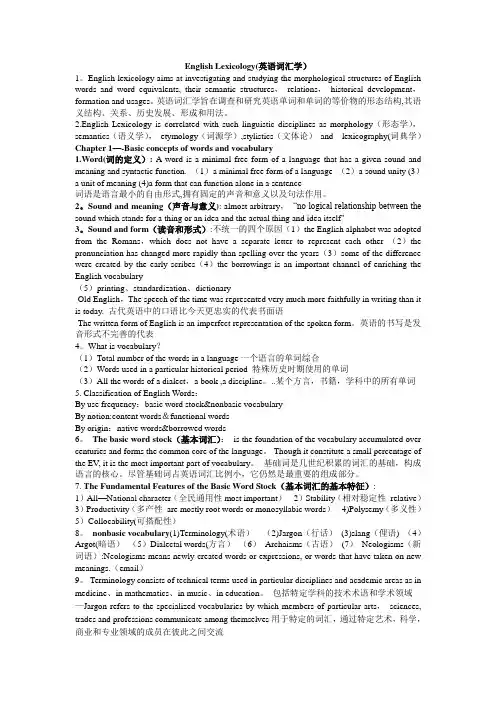
English Lexicology(英语词汇学)1。
English lexicology aims at investigating and studying the morphological structures of English words and word equivalents, their semantic structures,relations,historical development,formation and usages。
英语词汇学旨在调查和研究英语单词和单词的等价物的形态结构,其语义结构、关系、历史发展、形成和用法。
2.English Lexicology is correlated with such linguistic disciplines as morphology(形态学),semantics(语义学),etymology(词源学),stylistics(文体论)and lexicography(词典学)Chapter 1—-Basic concepts of words and vocabulary1.Word(词的定义): A word is a minimal free form of a language that has a given sound and meaning and syntactic function. (1)a minimal free form of a language (2)a sound unity (3)a unit of meaning (4)a form that can function alone in a sentence词语是语言最小的自由形式,拥有固定的声音和意义以及句法作用。
2。
Sound and meaning(声音与意义): almost arbitrary,“no logical relationship between the sound which stands for a thing or an idea and the actual thing and idea itself"3。
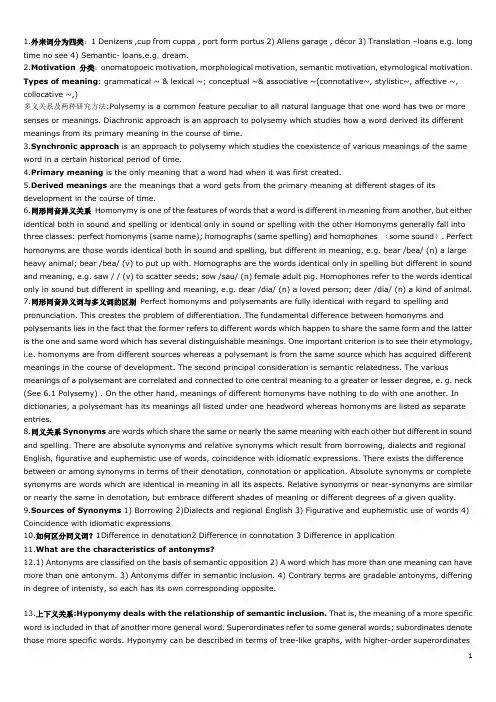
1.外来词分为四类:1 Denizens ,cup from cuppa , port form portus 2) Aliens garage , décor 3) Translation –loans e.g. long time no see 4) Semantic- loans.e.g. dream.2.Motivation 分类:onomatopoeic motivation, morphological motivation, semantic motivation, etymological motivation. Types of meaning: grammatical ~ & lexical ~; conceptual ~& associative ~(connotative~, stylistic~, affective ~, collocative ~,)多义关系及两种研究方法:Polysemy is a common feature peculiar to all natural language that one word has two or more senses or meanings. Diachronic approach is an approach to polysemy which studies how a word derived its different meanings from its primary meaning in the course of time.3.Synchronic approach is an approach to polysemy which studies the coexistence of various meanings of the same word in a certain historical period of time.4.Primary meaning is the only meaning that a word had when it was first created.5.Derived meanings are the meanings that a word gets from the primary meaning at different stages of its development in the course of time.6.同形同音异义关系Homonymy is one of the features of words that a word is different in meaning from another, but either identical both in sound and spelling or identical only in sound or spelling with the other Homonyms generally fall into three classes: perfect homonyms (same name); homographs (same spelling) and homophones (some sound). Perfect homonyms are those words identical both in sound and spelling, but different in meaning, e.g. bear /bea/ (n) a large heavy animal; bear /bea/ (v) to put up with. Homographs are the words identical only in spelling but different in sound and meaning, e.g. saw / / (v) to scatter seeds; sow /sau/ (n) female adult pig. Homophones refer to the words identical only in sound but different in spelling and meaning, e.g. dear /dia/ (n) a loved person; deer /dia/ (n) a kind of animal.7.同形同音异义词与多义词的区别Perfect homonyms and polysemants are fully identical with regard to spelling and pronunciation. This creates the problem of differentiation. The fundamental difference between homonyms and polysemants lies in the fact that the former refers to different words which happen to share the same form and the latter is the one and same word which has several distinguishable meanings. One important criterion is to see their etymology, i.e. homonyms are from different sources whereas a polysemant is from the same source which has acquired different meanings in the course of development. The second principal consideration is semantic relatedness. The various meanings of a polysemant are correlated and connected to one central meaning to a greater or lesser degree, e. g. neck (See 6.1 Polysemy) . On the other hand, meanings of different homonyms have nothing to do with one another. In dictionaries, a polysemant has its meanings all listed under one headword whereas homonyms are listed as separate entries.8.同义关系Synonyms are words which share the same or nearly the same meaning with each other but different in sound and spelling. There are absolute synonyms and relative synonyms which result from borrowing, dialects and regional English, figurative and euphemistic use of words, coincidence with idiomatic expressions. There exists the difference between or among synonyms in terms of their denotation, connotation or application. Absolute synonyms or complete synonyms are words which are identical in meaning in all its aspects. Relative synonyms or near-synonyms are similar or nearly the same in denotation, but embrace different shades of meaning or different degrees of a given quality.9.Sources of Synonyms 1) Borrowing 2)Dialects and regional English 3) Figurative and euphemistic use of words 4) Coincidence with idiomatic expressions10.如何区分同义词?1Difference in denotation2 Difference in connotation 3 Difference in application11.What are the characteristics of antonyms?12.1) Antonyms are classified on the basis of semantic opposition 2) A word which has more than one meaning can have more than one antonym. 3) Antonyms differ in semantic inclusion. 4) Contrary terms are gradable antonyms, differing in degree of intenisty, so each has its own corresponding opposite.13.上下义关系:Hyponymy deals with the relationship of semantic inclusion. That is, the meaning of a more specific word is included in that of another more general word. Superordinates refer to some general words; subordinates denotethose more specific words. Hyponymy can be described in terms of tree-like graphs, with higher-order superordinates above the lower subordinates. But their status either as superordinate or subordinate is relative to other terms. For example, horse, dog, pig are subordinates in relation to animal, but superordinates of mare, hound and boar, Animal itself becomes a subordinate of creature. And creature in turn becomes14.词义变化的种类There are five types of meaning, changes: extension, narrowing, degradation, elevation, and transfer among which extension and narrowing are the most common. Changes in meaning can be accounted for from extra-linguistic factors (historical reason, class reason, and psychological reason) and intra-linguistic factors (shortening, the influx of borrowing, and analogy).15.词义的扩大Extension is a process by which a word with a specialized sense is generalized to cover a broader or less16.definite concept. Compare the following;词义的缩小Narrowing is a process by which a word of wider meaning acquires a specialized sense;词义的升华Elevation is a process by which a word moves from a derogatory or neutral sense to a neutral and/or appreciative sense;词义的降格Degradation is a process by which a word of reputation slides into a pejorative use,;词义的转移Transfer is a process by which a word denoting one thing changes to refer to a different but related thing. Paper serves as an example. This word formerly denoted an African plant papyrus, which was once used to make paper. In modern times, paper is made from rags, wood, straw and the like, but the product has retained the same name. There is associated transfer. There are other kinds of transfer, such as, concrete to abstract, abstract to concrete and transfer of sensation.17.语境的种类:非语言语境。
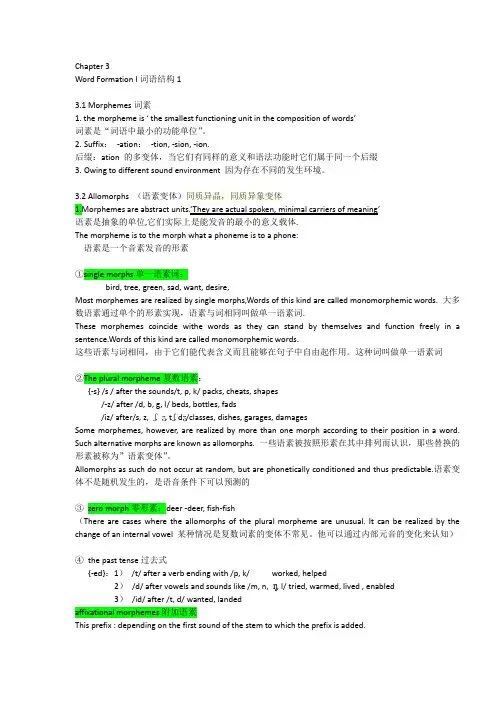
Chapter 3Word Formation I词语结构13.1 Morphemes词素1. the morpheme is ‘ the smallest functioning unit in the composition of words’词素是“词语中最小的功能单位”。
2.Suffix:-ation:-tion, -sion, -ion.后缀:ation 的多变体,当它们有同样的意义和语法功能时它们属于同一个后缀3.Owing to different sound environment 因为存在不同的发生环境。
3.2 Allomorphs (语素变体)同质异晶,同质异象变体1.Morphemes are abstract units.‘They are actual spoken, minimal carriers of meaning’语素是抽象的单位,它们实际上是能发音的最小的意义载体.The morpheme is to the morph what a phoneme is to a phone:语素是一个音素发音的形素①single morphs单一语素词:bird, tree, green, sad, want, desire,Most morphemes are realized by single morphs,Words of this kind are called monomorphemic words.大多数语素通过单个的形素实现,语素与词相同叫做单一语素词.These morphemes coincide withe words as they can stand by themselves and function freely in a sentence.Words of this kind are called monomorphemic words.这些语素与词相同,由于它们能代表含义而且能够在句子中自由起作用。
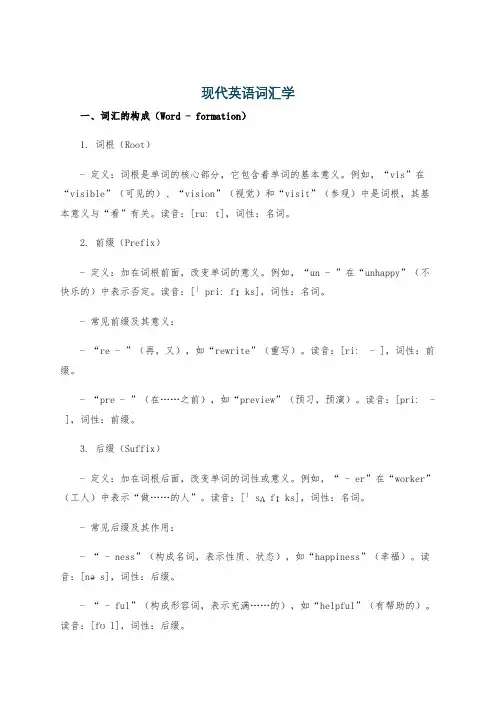
现代英语词汇学一、词汇的构成(Word - formation)1. 词根(Root)- 定义:词根是单词的核心部分,它包含着单词的基本意义。
例如,“vis”在“visible”(可见的)、“vision”(视觉)和“visit”(参观)中是词根,其基本意义与“看”有关。
读音:[ruːt],词性:名词。
2. 前缀(Prefix)- 定义:加在词根前面,改变单词的意义。
例如,“un - ”在“unhappy”(不快乐的)中表示否定。
读音:[ˈpriːfɪks],词性:名词。
- 常见前缀及其意义:- “re - ”(再,又),如“rewrite”(重写)。
读音:[riː - ],词性:前缀。
- “pre - ”(在……之前),如“preview”(预习,预演)。
读音:[priː - ],词性:前缀。
3. 后缀(Suffix)- 定义:加在词根后面,改变单词的词性或意义。
例如,“ - er”在“worker”(工人)中表示“做……的人”。
读音:[ˈsʌfɪks],词性:名词。
- 常见后缀及其作用:- “ - ness”(构成名词,表示性质、状态),如“happiness”(幸福)。
读音:[nəs],词性:后缀。
- “ - ful”(构成形容词,表示充满……的),如“helpful”(有帮助的)。
读音:[fʊl],词性:后缀。
二、词性(Parts of Speech)1. 名词(Noun)- 定义:表示人、事物、地点、抽象概念等。
例如,“book”(书)、“city”(城市)、“love”(爱)。
读音:[naʊn],词性:名词。
- 名词的分类:- 可数名词(Countable Noun),如“apple”(苹果),有单复数形式。
- 不可数名词(Uncountable Noun),如“water”(水),一般没有复数形式。
2. 动词(Verb)- 定义:表示动作或状态。
例如,“run”(跑)、“be”(是)。
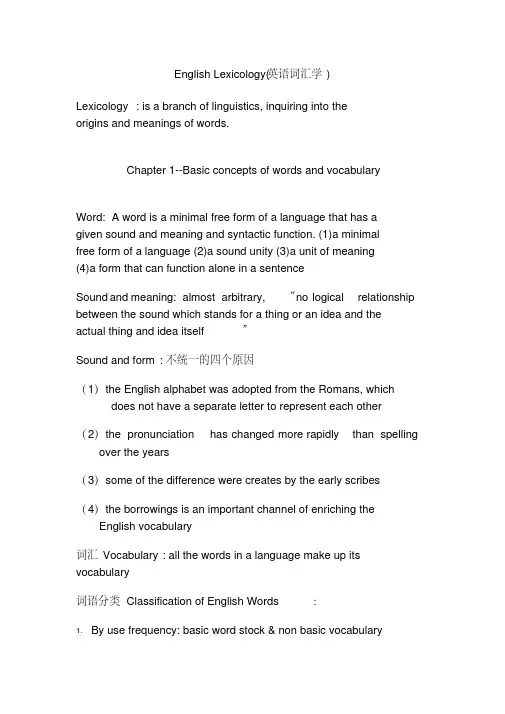
English Lexicology(英语词汇学)Lexicology: is a branch of linguistics, inquiring into theorigins and meanings of words.Chapter 1--Basic concepts of words and vocabularyWord: A word is a minimal free form of a language that has agiven sound and meaning and syntactic function. (1)a minimalfree form of a language (2)a sound unity (3)a unit of meaning(4)a form that can function alone in a sentenceSound and meaning: almost arbitrary, “no logical relationship between the sound which stands for a thing or an idea and theactual thing and idea itself”Sound and form:不统一的四个原因(1)the English alphabet was adopted from the Romans, which does not have a separate letter to represent each other(2)the pronunciation has changed more rapidly than spelling over the years(3)some of the difference were creates by the early scribes(4)the borrowings is an important channel of enriching the English vocabulary词汇Vocabulary: all the words in a language make up its vocabulary词语分类Classification of English Words:1.By use frequency: basic word stock & non basic vocabulary基本词汇的特征:1)All-National character(全民通用性most important)2)Stability3)Productivity(多产性) 4)Polysemy(多义性)5)Collocability(可搭配性)没有上述特征的词:(1)Terminology(术语) (2)Jargon(行话)(3)slang(俚语)(4)Argot(暗语)(5)Dialectal words (6)Archaisms(古语) (7) Neologisms(新词语):Neologisms2.By notion: content words实词 & functional words虚词3.By origin: native words & borrowed wordsNative words(本族语词): Two other features:(1)neutral instyle (2)frequent in useBorrowed words/Loan words: words taken over from foreign languages.(80% of modern EV)1) denizens(同化词,融入英语): (shirt from skyrta(ON))2) aliens(非同化词/外来词,可以看出源头): kowtow3) translation loans(译借词):按其他语言方式组成英语long time no see / tofu4) semantic loans(借义词):they are not borrowed withreference to the form,but their meanings are borrowedpioneer本指开拓者,先引申为先锋。
词汇期末复习( C1 -C7 )Chapter 1一、 Word 词的定义a minimal free form (最小的自由形式)a sound unitya semantic unity ( meaning )a form that can function alone in a sentence. (具有句法功能)(1) (2) (3) (4) 二、 Vocabulary 词汇的定义All the words in a language make up what is generally known as vocabulary.一般来说,词汇指的是一种语言里所有单词的总和。
词的总和构成语言的词汇。
词与词汇之间的关系是个体与总体之间的关系。
三、Sound&Meaning 发音和意义The connection between the sound (form) and meaning is arbitrary ( 任意的 ) and conventional. 二者的关系是约定俗成、随意的四、 Sound & Form 发音和形式(正字的) (1) The written form of a natural language is the orthographical form.record of the oral 自然语言的书写形式是口语形式的书写记录。
发音与形式不同的原因: (2) The reasons of differences occur between sound and form: ① ② 英语字母表来自罗马English alphabet was adopted from the Romans 发音改变快 the pronunciation has changed more rapidly than spelling over the years. 速③ ④ Differences created by professional scribes. 专业抄写员的不同More differences brought by the continuing change of sounds and the standardization of spelling. 发音不断变化,书写标准化。
自考2英语词汇学考试重点精华整理一、词汇学概述1、语言与词汇的关系:语言是词汇和语法规则的总和,而词汇则是语言中最基本的元素。
2、词汇学的定义:词汇学是研究语言的词汇以及词汇的起源、演变、语义和语用等方面的学科。
3、词汇学的研究对象:主要包括词汇的起源、演变过程、语义变化、文化背景等。
二、英语词汇的历史演变1、英语的起源:英语起源于古代日耳曼语,经过长时间的演变和发展,形成了今天的英语。
2、英语词汇的演变:英语词汇经历了许多变化,包括词义的变化、词形的变化、外来词的引入等。
3、英语词汇的分类:英语词汇可以根据其来源、语义、语法等方面进行分类。
三、英语词汇的语义关系1、同义词与反义词:同义词是指具有相同或相似意义的词汇,而反义词则是指具有相反意义的词汇。
2、上下义词与下义词:上下义词是指在一个词汇的语义场中,一个词可以表示另一个词的上层概念或下层概念。
3、词汇的文化意义:词汇的文化意义是指词汇在特定文化背景中所具有的意义。
四、英语词汇的记忆与运用1、记忆策略:记忆策略是指通过一定的方法来提高记忆效率,包括联想记忆、语境记忆等。
2、运用技巧:运用技巧是指在使用词汇时需要注意的事项,包括语用、语法等方面。
3、常见错误分析:常见错误分析是指对学生在使用词汇时容易犯的错误进行分析和纠正。
五、英语词汇的学习方法与技巧1、学习策略:学习策略是指通过一定的方法来提高学习效率,包括制定学习计划、使用学习工具等。
2、学习技巧:学习技巧是指在学习过程中需要注意的事项,包括如何集中注意力、如何提高学习效率等。
3、学习资源:学习资源是指在学习过程中可以使用的各种资源,包括书籍、网站、课程等。
词汇学是语言学的一个分支,主要研究词汇的起源、发展、变化和用法。
它涉及对单词的音、形、义、语法特征和语用意义等方面的研究。
词汇学有一些基本概念,包括词、词汇、词素、词义、语境等。
词是语言中最小的、可以独立使用的意义单位,词汇是语言中所有词的总和,词素是构成词的要素,词义是词的含义,语境是指词所处的语言环境。
英语词汇学精华版一、选择1-15;二、填空16-20*2;三、四、21-40选择连线;五、41-45名词解释*2;六、简答46-48*4;七、分析综合49-50*9针对复习:一、选择:二、填空:三、四、选择连线*****1、types of morphemes: Free morphemes; bound morphemes; inflectional morphemes.2、types of bound morphemes:Prefix; Suffix.3、types of idioms: Idioms Nominal in nature; Idioms Adjectival in nature; IdiomsVerbal in nature; Idioms Adverbal in nature; sentence idioms.4、types of word meaning: Grammatical meaning and lexical meaning; conceptualmeaning and associative meaning (connotative meaning\stylistic ~\affective~\collocative ~)5、idioms stylistic features: colloquialisms; slang; literary expressions.6、idioms rhetorical features:phonetic manipulation (alliteration\rhyme); lexical manipulation(reiteration\repetition\juxtaposition);figures of speech(simile\metaphor\metonymy\synecdovhe\euphemism\personification)7、types of word formation: affixation; compounding; conversion; blending; clipping;acronym; back-formation; word from proper names.8、changes in wording: extension; narrowing; elevation; degradation; transfer.9、types of motivation: morphological motivated; semantic ~; etymological ~;onomatopoeic ~10、语系划分的标准Estern set : Balto-Slavic(Prussian, Lithuanian , Polish ,Czech, Bulgarian ,Slovenian and Russian.), Indo-Iranian(Persian, Hindi), Armenian and Albanian;Western set : Celtic(Scottish, Irish, Welsh, Breton), Italic(Portuguese, Spanish, French, Italian , Roumanian) , Hellenic(Greek), Germanic(Norwegian ,Icelandic, Danish and Swedish, English, German).五、41-45名词解释*2;Lexicology is a branch of linguistics, inquiring into the origins and meanings of words.Morphology : the study of morpheme and their different forms.Semantics:the study of word meaning.Etymology: the study of the origin of words, and of their history and changes intheir meaning.Stylistics : the study of the variation in language which is dependent on the situation in which the language is used and also on the effect the writer or speaker wishes to create on the reader or hearerLexicography : the compiling of dictionaries.Synchronic study : the study of a word or words at one particular point in time.Diachronic study: a n approach to lexicology which studies how a word (or words)changes over a period of time.word: a word is a minimal free form of a language that has a given sound andmeaning and syntactic function.vocabulary:Vocabulary refers to the total number of the words in a language, but it can stand for all the words used in a particular historical period.Vocabulary also refers to all the words of a given dialect, given book, a given discipline and the words possessed by an individual person.Terminology术语consists of technical terms used in particular disciplines andacademic areas as in medicine:Jargon行话refers to the specialized vocabularies by which members of particular arts, sciences, trades and professions communicate among themselves such as inbusiness.slang俚语belongs to the sub-standard language, a category that seems to stand between the standard general words including informal ones available to everyoneand in-group wordsArgot黑话generally refers to the jargon of criminals. Its use is confined to the sub-cultural groups, and outsiders can hardly understand it,Archaism s古词语are words or forms that were once in common use but are nowrestricted only to specialized or limited use.Neologisms新词语are newly-created words or expressions, or words that have takenon new meanings.denizen s同化词are words borrowed early in the past and now are well assimilatedinto the English language.Alien非同化词are borrowed words which have retained their original pronunciationand spelling.Translation-loans. 借译词Translation-loans are words and expressions formed from the existing material in the English language but modelled on the patterns taken fromanother language.Semantic-loan s借义词Words of this category are not borrowed with reference to theform. But their meanings are borrowed.Content word: the basic word stock is the foundation of the vocabulary ,which accumulated over centuries and forms the common core of the language. It is the mostimportant part of vocabulary.Creation : the formation of new words by using the existing materials, namely roots, affix es and other elements. Semantic change means an old form which takes on anew meaning to meet the new need.Morpheme: the smallest meaningful unit in a languageAllomorph: any of the different forms of a morphemeFree morpheme: a linguistic form which can be used on its own as a wordBound morpheme: a form (morpheme) which can not he used alone hut must be used with another morpheme. Bound morphemes include hound roots and affixesAffixes: forms that are attached to words or word elements to modify meaning or functionPrefixation(suffixation): is the formation of new words by adding prefixes(suffixes) to stemInflectional affixes: affixes attached to the end of words to indicate grammatical relationshipsDerivational affixes: affixes added to other morphemes to create new wordsRoot: a morpheme which is the basic part of a word that can not be further analyzed without total loss of identityStem: a form to which affixes of any kind can be addedBound root: a root that can not stand alone as a wordMonomorphemic words: words that have nothing more than a free morphemeAffixation: Derivation (also known as affixation) is the process of formation of words by adding word-forming or derivational affixes to stems. Affixaton consisits of prefixation and suffixation. Prefixation is the formation of new words by adding prefixes to stems; suffixation is the formation of new words by adding suffixes tostems.Compounding: Compounding or composition is the formation of new words by joining two or more stems. Words formed in this way tire called compounds.Conversion:Conversion is the formation of new words by converting words of one class to another class. Functional shift = conversion Zero-derivation .Adjective to noun :(1) full conversion (2) partial conversionAcronymy Acronymy is the process of forming new words by joining the initial letters of neames of social and political organizations or special noun phrases and technical terms Acronymy包含两类:1) initialisms (不发音)e.g. BBC, VOA, TB2)acronyms (形成新的发音)e.g. CORE, TEFLBlending is the formation of new words by combining parts of two words or a won!plus a part of another word. Words formed by blending are called blends orpormanteau.Clipping is a way of making new words which involves the shortening a longer word by cutting a part off the original and using what remains instead.Back-formation is a process of forming new words considered to the opposite process of suffixation by the removal of an affix from existing word.Words from proper names of place, people, trade, book, etc.Concept,is beyond language, is the result of human cognition, reflecting the objectiveworld in the human mindSense : denotes the relationships inside the language.Reference is the relationship between language and the world.definite concept. Compare the following;词义的缩小Narrowing is a process by which a word of wider meaning acquires a specialized sense;词义的升华Elevation is a process by which a word moves from a derogatory or neutral sense to a neutral and/or appreciative sense;词义的降格Degradation is a process by which a word of reputation slides into a pejorative use,;词义的转移Transfer is a process by which a word denoting one thing changes to refer to a different but related thing. Paper serves as an example. This word formerly denoted an African plant papyrus, which was once used to make paper. In modern times, paper is made from rags, wood, straw and the like, but the product has retained the same name. There is associated transfer.There are other kinds of transfer, such as, concrete to abstract, abstract toconcrete and transfer of sensation.语境的种类:非语言语境。